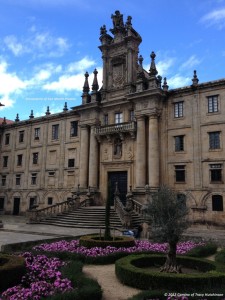
Today I’ve descended along the Rua do Gozo that flows into the Rua da Ponte de San Lázaro, a circular junction to slower traffic coming and going from Santiago and an overpass above the Av. de Camilo José Cela, that’s framed by four crosswalks. Pedestrians’ Russian roulette skills are tested because drivers seem confused as to who has the right-of-way. A scattered line of pilgrims ahead of me cautiously make their way across, disappearing into downward left-bending streets. I follow into the conical streets, gravity pulling me toward the bottom, where the cathedral rests, like an anchor.
I plod along Rua San Pedro until I come to Porta do Camiño. There’s no door as the name might imply, just stubby cylindric posts to prevent anything other than foot traffic and cyclists from entering. I cross over this threshold, leaving the shiny contemporary Santiago behind and enter the Santiago of yore, where the title de Compostela is added (meaning the burial ground of a Saint). A tightness in my chest releases, making way for a recently developed preference for ancient cities, especially those that haven’t sacrificed authenticity for modernity. The closeness of the buildings along the narrow streets is as cozy as swaddling. My contentment moves down my legs inspiring a light-footedness in my stride.
Through a café window I see a woman, about my age, who strikes me as familiar. I wonder if we’ve met somewhere along the Camino. I smile at her, realizing I’m staring. She smiles back, when I realize I’m seeing a reflection of myself, or a most recent version of myself. I look at her smooth, yet weathered face. The chatter of people passing behind me fades to a hush, then a whisper. With another smile, I turn and continue on until the street becomes an inlet to the Plaza de Cervantes. The sunlight shines intently on the focal point of the plaza – a ten-foot or so pillar, with a bust of a man at the top that I recognize instantly. I know him affectionally as Don Quixote, but others refer to him as the satiric poet and author, Miguel de Cervantes. The sight of him reminds me that, Our greatest foes, and whom we must chiefly combat, are within. With a grateful nod, I walk on.

I return to the narrow streets that block the sun’s warmth and stroll along for several more meters until I reach the Supermercado el Dubres, a super small market and the end of yet another street into a large rectangular space of unscalable boundaries – even to the eye – formed by regal structures mostly of varying shades of grey. The Plaza de Inmaculada, also known as the Plaza de la Azabacheria, is immaculate in every way. The lateness of the day puts the Monasterio of San Martin Pinario in the spotlight, bringing its veiny beige stone alive. The interwoven architectures, like Baroque and Romanesque, are yet another reminder of the many cultures that have held claim to Santiago de Compostela over the centuries. The square is captivating and for a moment I forgot the pilgrim’s goal: crossing the invisible finish line at the foot of the cathedral. A tourist backs into me, attempting to fit what’s possibly the oldest structure in this plaza into the lens of his camera. Unbeknownst to me, he’s capturing the north façade of the cathedral. For all intents and purposes, I have arrived.
Pilgrim Tracy HutchinsonU.S.A.
lifecoachonthecamino.blogspot.com
@samuraicoach
Completed first Camino in 2012

Hi!
I stumbled across your blog – it’s a great blog btw!
This winter I am going to be walking from Prague to Finisterre on my second pilgrimage and I also have a blog: http://www.mycaminosantiago.com
Would you like to exchange links?
If you would like to then pls feel free to let me know and I will place a link to your blog on my site and I would please ask you to also place a link to my blog on your site. Your link would go here:
http://mycaminosantiago.com/links/
Thank you for your time and Buen Camino!
I write these blog posts for the documentary film. You’ll need their permission for the swap. Thank you for visiting.
Tracy